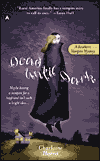
Anyone who has not read the essay, "Caring for Your Introvert", from a 2003 issue of The Atlantic, should go read it right now. Introverts and extroverts alike. It's apparently one of the most popular essays they ever published, and I love it. I am very introverted and I think this essay is the best, most spot-on description of it I've ever read.
I was reminded of this article at work one day this week. A co-worker (very much an extrovert) asked me if I wouldn't like to eat lunch with the girls. When I said that I was a little tired and would rather sit at my desk with a book, she looked at me like I had two heads. I wanted to shout, "I've been dealing with people since I got here, and my phone has been ringing off the hook, and now I just want to sit here quietly and not deal with anyone! It doesn't mean I don't like you, I just don't feel like talking to you right now!" But of course, I can't actually say that, because she's really a very nice person and besides, she just wouldn't get it. I wanted to print up a copy of this article and shove it in her face.
Okay, that little rant is over. But reading this essay again got me thinking about introverted book characters. I took a wander through my bookshelves and realized that I couldn't think of too many truly introverted characters. This surprises me. I think most serious booklovers are introverts. Not to say all are, but reading is a quiet, solitary thing best suited to us introverts. And I'm guessing that many writers are introverts for the same reasons. So why don't they write more introverted characters?
Well, anyway. Here's a list of the introverted protagonists I could come up with:
- Mr. Darcy in Pride and Prejudice, by Jane Austen. He has to be top of the list because he's probably the best-known introverted character ever.
"I certainly have not the talent which some people possess," said Darcy, "of conversing easily with those I have never seen before. I cannot catch their tone of conversation, or appear interested in their concerns, as I often see done."
- Beth in Little Women, by Louisa May Alcott. Beth is an example of an introvert who is also shy. I think a lot of people think shyness and introversion is the same thing, and it's really not.
Her father called her "Little Tranquility," and the name suited her excellently; for she seemed to live in a happy world of her own, only venturing out to meet the few whom she trusted and loved.
- Captain Horatio Hornblower in Beat to Quarters (and all the rest of the Hornblower books) by C. S. Forester. Horatio is described on the jacket flap of my copy as "endearingly self doubting" which sums him up pretty well. And he likes his quiet time:
Bush, the first lieutenant, was officer of the watch, and touched his hat but did not speak to him; in a voyage which had by now lasted seven months without touching land he had learned something of his captain's likes and dislikes. During this first hour of the day the captain was not to be spoken to, nor his train of thought interrupted.
- Princess Ani in The Goose Girl, by Shannon Hale. I love this book because it proves that an introvert can be a better ruler/leader than an extrovert. It also gave me the term "people-talker," which is great:
"Some people are born with the first word of a language resting on the tongue, though it may take some time before they can taste it. . . . The gift of people-speaking. Many rulers do [have this gift]. And people listen to them, and believe them, and love them. . . . It can be powerful and good, and it can also be dangerous."
- Lena in The Sisterhood of the Traveling Pants, by Ann Brashares.
It was her last breakfast with Bapi, her last morning in Greece. In her frenetic bliss that kept her up till dawn, she'd scripted a whole conversation in Greek for her and Bapi to have as their grand finale of the summer. Now she looked at him contentedly munching on his Rice Krispies, waiting for the right juncture for launch time.
He looked up at her briefly and smiled, and she realized something important. This was how it was supposed to be. This was how they both liked it. Though most people felt bonded and comforted by conversation, Lena and Bapi were two of the kind who didn't. They bonded by the routine of just eating cereal together.
- Valancy in The Blue Castle, by L. M. Montgomery. Like Montgomery's more well-known Anne, Valancy is dreamy and imaginative, a home body.
She also amused herself by picturing Barney and herself going to the dances and dinners in the houses on the islands, but she did not want to go in reality. Once they did go to a masquerade dance in the pavilion at one of the hotels up the lake, and had a glorious evening, but slipped away in their canoe, before unmasking time, back to the Blue Castle.















